When it comes to baking macarons, the choice of baking sheet can have a significant impact on the final product. Macarons are delicate confections that require consistent heat distribution to achieve their characteristic smooth tops and ruffled feet. In my experience as a baker, I’ve found that aluminum baking sheets are often recommended due to their even heat conductivity, which is crucial for preventing the macarons from sticking or becoming misshapen during baking.
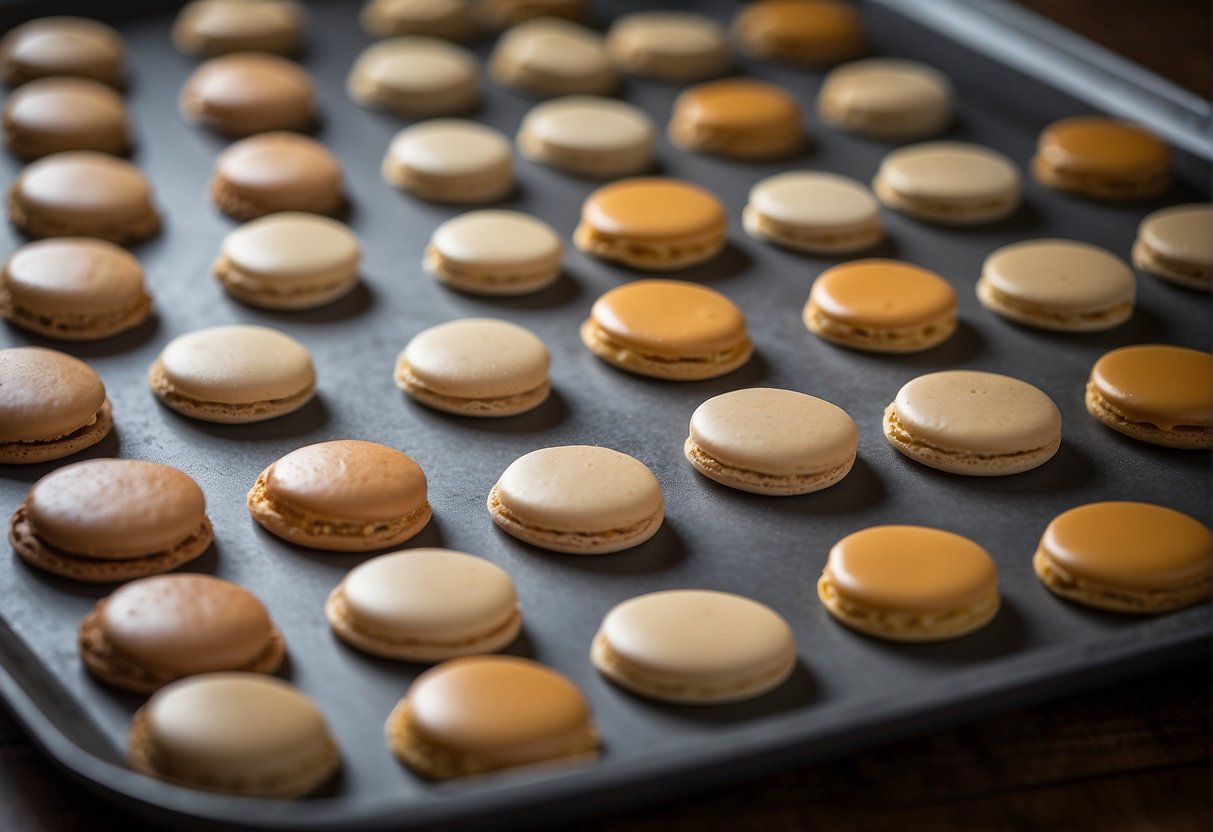
However, the texture and thickness of the baking sheet are not the only factors to consider. The surface you choose to bake on plays a role as well. Some bakers prefer using nonstick surfaces or silicone mats that fit onto the baking sheet for an effortless release of the macarons after baking. These baking mats can also provide guidelines for piping uniform shells and can be a reusable and environmentally friendly alternative to parchment paper.
When selecting the best baking sheet for macarons, it’s important to consider your specific needs, whether it’s ensuring even heat distribution, preventing sticking, or aspiring for perfectly sized macarons. Choosing the right baking sheet, such as those recommended by experts, can make the process smoother and more enjoyable, leading to beautiful and delicious macarons.
Choosing the Right Baking Sheet
When I bake macarons, choosing the right baking sheet is crucial. My go-to options are high-quality half-sheet pans, as their ample space allows macarons to spread out and bake evenly without crowding.
I recommend non-stick unbleached baking sheets because they help in the easy release of macarons after baking. However, if you prefer a more traditional approach, aluminum pans like the Nordic Ware Naturals Quarter Sheet provide excellent heat conductivity. I avoid using an old stainless steel pan since it can lead to uneven baking results.
Here are a few points to consider:
-
Size: Finding the right size is key. For home bakers, I find half-sheet pans to be the most versatile. They typically measure 18″ x 13″ and fit most ovens comfortably.
-
Material: For optimum heat distribution, I lean towards aluminum sheets. The Wildone Baking Sheet is a good example and even comes with silicone mats, perfect for macarons.
-
Quality: A high-quality sheet pan can make all the difference. It should be sturdy, resist warping, and facilitate even heating.
It’s worth investing in a good quality sheet pan from the start; it’ll be a cornerstone of my baking tools and deliver consistently well-baked macarons.
Understanding Macaron Basics
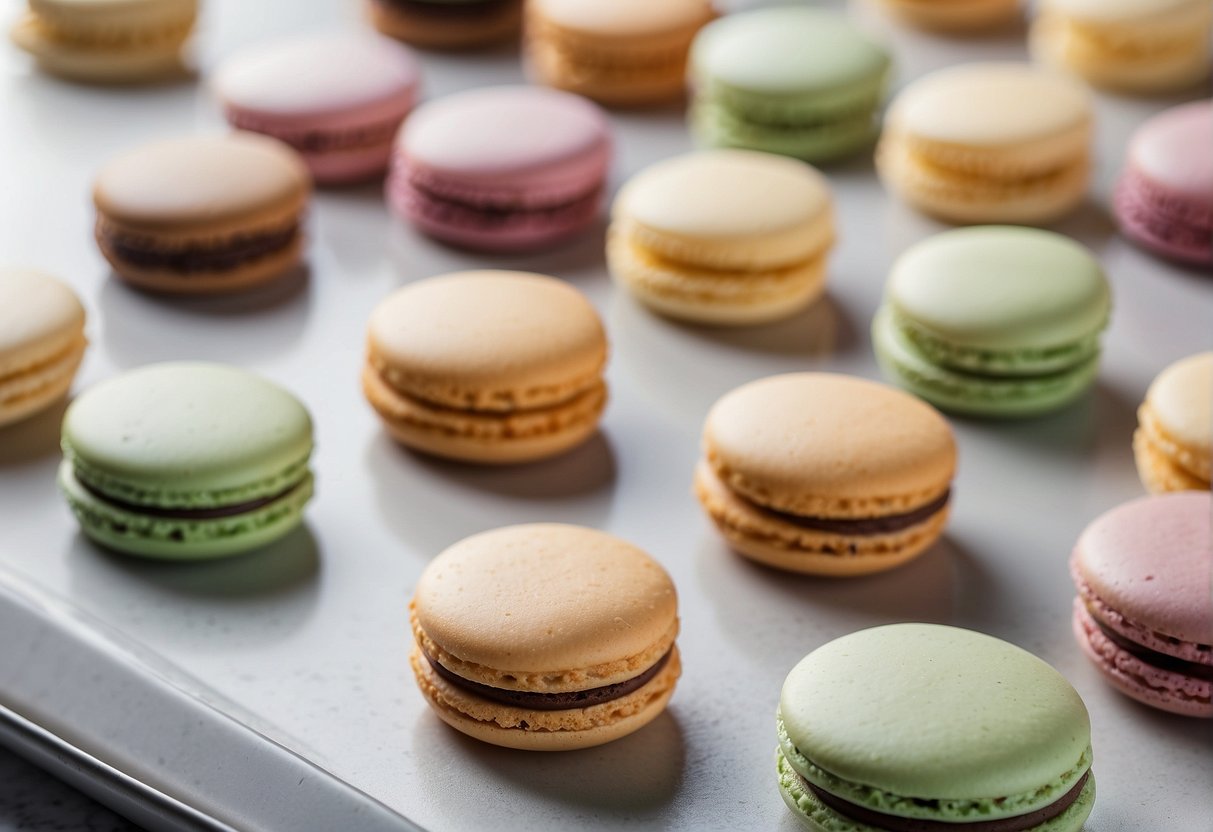
When baking macarons, precision is key; from the oven temperature to the meringue technique, each step plays a crucial role in achieving the perfect cookie.
The Importance of Oven Temperature
For macarons, maintaining the correct oven temperature is essential. Using an oven thermometer can ensure the right environment, as even a slight deviation in temperature can lead to cracking or undercooked macarons. Most basic recipes recommend a temperature of around 300 degrees Fahrenheit, but this might vary slightly depending on your oven.
Meringue: Reaching Stiff Peaks
Achieving stiff peaks in your meringue – where the egg whites are whipped to a firm and glossy appearance – is foundational for both French macarons and Italian macarons. This step typically involves aged egg whites and superfine sugar. Patience and a stand mixer or an electric mixer can help reach the desired consistency without over-beating.
The Key to Perfect Macaron Batter
The batter consistency is vital. Almond meal or almond flour mixed with dry ingredients should be folded into the meringue gently until it reaches a lava-like flow. Over or under-mixing can lead to issues. Additionally, incorporating food coloring should be done carefully to not deflate the mixture.
Macaron Mat vs. Parchment Paper
Using a silicone mat, like a Silpat mat, can provide consistent results due to its non-stick surface and printed guides. However, parchment paper is a suitable alternative that can yield excellent results when macarons are piped carefully and evenly spaced.
The Role of Equipment
Accurate tools can mean the difference between success and failure. A kitchen scale ensures precise measurements, while a food processor can help achieve a finer almond flour mixture. For piping, a pastry bag or reusable piping bag fitted with the correct tip size is important for uniformity among the shells.
Preparing for Baking
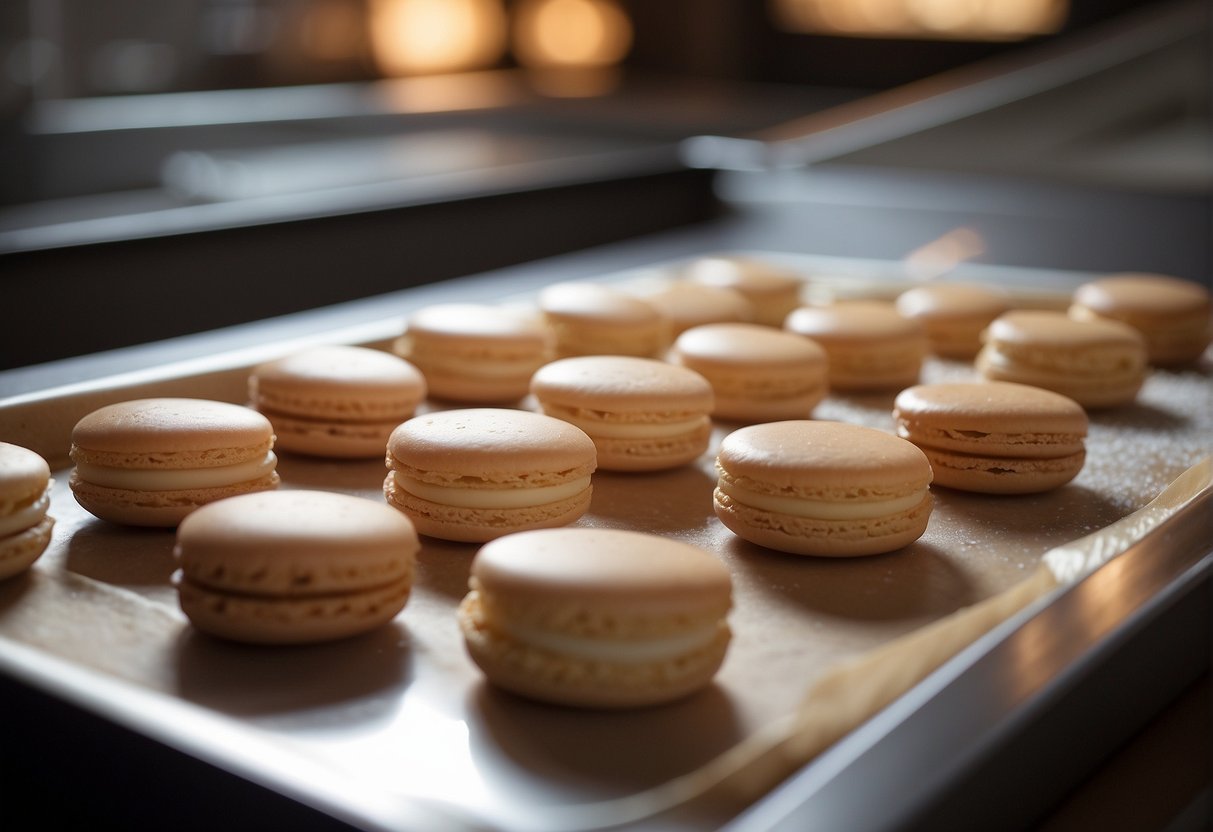
When preparing to bake macarons, the focus is on two crucial aspects: ensuring even heat distribution and creating consistent macaron shells. Both elements are key to achieving the perfect texture and uniformity that macarons are renowned for.
Ensuring Even Heat Distribution
The first step in baking macarons is making sure the heat distributes evenly across the baking sheet. For this, I always use a high-quality airbake tray. This type of tray helps to minimize the risk of hotspots in the heated oven, which can cause the macaron shells to become too brown or undercook. A uniform heat ensures each macaron develops that characteristic smooth top and ruffled foot.
Creating Consistent Macaron Shells
Consistency is key when piping macaron batter. Before I even start preheating my oven, my work surface is ready with macaron templates drawn on the back side of the paper. I ensure my piping technique is precise by practicing a few piped circles on the back of my paper to get a feel for my piping tip. Once I’m confident with my piping, I follow the template precisely, which leads to evenly sized macaron shells and a beautiful final product. The control I have over the size and shape of my macaron shells comes down to careful preparation and attention to detail during this phase.
Baking Technique and Tips
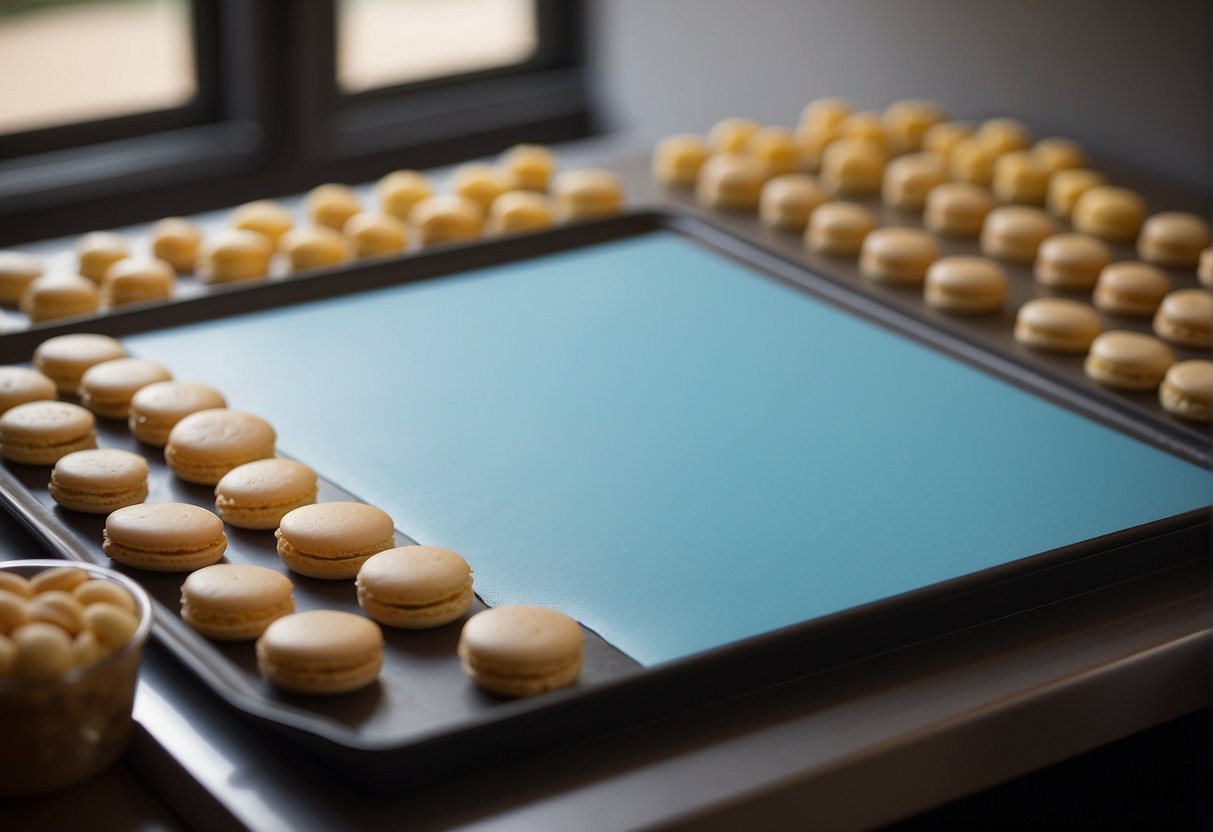
When it comes to baking macarons, precision is key. In my experience, both the method and the tools, like choosing a high-quality sheet metal baking sheet with a safe coating, play pivotal roles in achieving those picture-perfect confections.
Achieving Beautiful Macarons
To ensure beautiful macarons with the ideal shape, I start with a tried and true French macaron recipe. Precision in measuring ingredients is non-negotiable. I sift my almond flour and powdered sugar countless times to prevent large bits from compromising the smooth tops. Meticulously folding the batter to the so-called ‘lava stage’ and paying close attention to piping can drastically improve the aesthetics of your macarons.
25 Best Tips for Making Macarons
- Use Aged Egg Whites: Let the egg whites sit at room temperature for 24-48 hours or use aged egg whites to achieve better stability and structure.
- Sift Dry Ingredients: Sift almond flour and powdered sugar to remove lumps and ensure a smooth batter.
- Avoid Overmixing: Mix the batter just until combined to prevent overmixing, which can lead to flat macarons.
- Use a Macaronage Technique: Fold the dry ingredients into the meringue using a technique called macaronage, incorporating air while deflating the meringue slightly.
- Check for the Right Consistency: Aim for a lava-like consistency where the batter flows slowly off the spatula and forms a ribbon that sinks back into the batter after about 10 seconds.
- Pipe Uniform Macarons: Use a piping bag with a round tip to pipe uniform macarons of the same size onto parchment paper or silicone mats.
- Tap Out Air Bubbles: Tap the baking sheet on the counter a few times to release air bubbles trapped in the batter.
- Let Macarons Rest: Allow piped macarons to rest at room temperature for 30-60 minutes until a skin forms on the surface. This helps create the signature feet during baking.
- Preheat Oven Correctly: Preheat the oven to the correct temperature and use an oven thermometer to ensure accuracy.
- Bake in Batches: Bake macarons in small batches to ensure even cooking and consistent results.
- Rotate the Baking Sheet: Rotate the baking sheet halfway through baking for even heat distribution.
- Cool Completely: Allow baked macarons to cool completely on the baking sheet before removing them to prevent sticking.
- Pair Macaron Shells: Match macaron shells of similar size and shape to create perfect pairs for filling.
- Use a Ganache Filling: Prepare a ganache filling for added flavor and creamy texture. Chocolate ganache is a classic choice.
- Experiment with Flavors: Get creative with flavor combinations by adding extracts, food coloring, or other flavorings to the macaron shells or filling.
- Store Properly: Store filled macarons in an airtight container in the refrigerator to keep them fresh. Bring them to room temperature before serving.
- Practice Patience: Macarons improve with practice, so don’t get discouraged if your first batch isn’t perfect.
- Avoid Humidity: Be mindful of humidity as it can affect the texture and appearance of macarons. Avoid making them on rainy or humid days.
- Use Quality Ingredients: Use high-quality almond flour, powdered sugar, and flavorings for the best results.
- Experiment with Techniques: Try different techniques such as Italian meringue or French meringue to find what works best for you.
- Watch Tutorials: Watch tutorial videos or attend macaron-making classes to learn tips and tricks from experts.
- Keep it Simple: Start with basic flavors and techniques before experimenting with more complex recipes.
- Adjust for Altitude: If you live at high altitude, make adjustments to the recipe and baking time as needed.
- Practice Consistency: Aim for consistency in size, shape, and thickness of macaron shells for professional-looking results.
- Enjoy the Process: Making macarons can be challenging but also rewarding. Enjoy the process and have fun experimenting with different flavors and designs.
| Flavor | Description |
|---|---|
| Classic Vanilla | Smooth and creamy with a hint of vanilla sweetness. |
| Salted Caramel | Sweet and salty combination with rich caramel flavor. |
| Raspberry | Tangy and fruity raspberry flavor with a hint of sweetness. |
| Pistachio | Nutty and earthy flavor with a hint of sweetness. |
| Lemon | Zesty and refreshing lemon flavor, perfect for citrus lovers. |
| Chocolate | Rich and decadent chocolate flavor, perfect for chocolate enthusiasts. |
| Strawberry | Sweet and fruity strawberry flavor with a hint of tartness. |
| Hazelnut | Nutty and slightly sweet flavor reminiscent of hazelnut spread. |
| Lavender | Floral and aromatic lavender flavor, subtle and elegant. |
| Matcha | Earthy and slightly bitter green tea flavor, perfect for matcha lovers. |
| Coconut | Sweet and tropical coconut flavor, reminiscent of a vacation in paradise. |
| Rose | Floral and delicate rose flavor, adds a touch of elegance to any occasion. |
| Earl Grey | Bold and aromatic bergamot flavor with a hint of citrus. |
| Cookies and Cream | Indulgent combination of creamy vanilla and crunchy chocolate cookie bits. |
| Blueberry | Sweet and juicy blueberry flavor, bursting with fruity goodness. |
| Orange | Bright and citrusy orange flavor, perfect for a refreshing treat. |
| Mint Chocolate | Cool and refreshing mint flavor paired with rich chocolate. |
| Dulce de Leche | Creamy and caramelized flavor with a hint of sweetness. |
| Almond | Nutty and slightly sweet almond flavor, classic and comforting. |
| Passion Fruit | Tropical and tangy passion fruit flavor, adds a burst of sunshine to any day. |
| Red Velvet | Rich and velvety red velvet flavor, perfect for a special occasion. |
| Cotton Candy | Sweet and nostalgic cotton candy flavor, perfect for kids and kids at heart. |
| Pumpkin Spice | Warm and spicy pumpkin flavor with hints of cinnamon and nutmeg. |
| Cherry | Sweet and juicy cherry flavor, reminiscent of summertime. |
| Espresso | Bold and robust coffee flavor, perfect for coffee lovers. |
Addressing Common Macaron Issues
I’ve answered a lot of questions from home bakers about common macaron problems. Air bubbles are a frequent culprit; they can be minimized by firmly tapping the tray against the countertop. Furthermore, an uneven oven rack can lead to lopsided macarons, so I always make sure my oven rack is level before baking. And a consistent oven temperature is crucial—I recommend an oven thermometer to keep it in check.
Top 10 Mistakes To Avoid When Making Macarons
- Using Fresh Egg Whites: Fresh egg whites contain more moisture, making it difficult to achieve the desired consistency for macaron batter. Use aged egg whites for better stability and structure.
- Overmixing or Undermixing: Overmixing or undermixing the batter can lead to macarons with flat tops, no feet, or hollow shells. Follow the macaronage technique and mix the batter just until it reaches the proper consistency.
- Skipping the Resting Time: Allowing piped macarons to rest at room temperature is crucial for forming a skin on the surface. Skipping this step can result in cracked or uneven shells.
- Incorrect Oven Temperature: Baking macarons at the wrong temperature can cause uneven baking, resulting in cracked or undercooked shells. Use an oven thermometer to ensure accurate temperature control.
- Opening the Oven Door: Avoid opening the oven door while baking macarons, as it can cause temperature fluctuations and lead to uneven baking or collapsed shells.
- Using Warped Baking Sheets: Warped or uneven baking sheets can result in misshapen macarons. Use flat and sturdy baking sheets for even heat distribution.
- Inconsistent Macaron Sizes: Inconsistent piping of macaron shells can lead to uneven baking and difficulty matching pairs for filling. Use a template or piping guide to ensure uniformity in size and shape.
- Adding Too Much Food Coloring: Excessive food coloring can alter the texture and consistency of macaron batter, leading to undesirable results. Use gel or powdered food coloring sparingly to avoid over-saturating the batter.
- Underbaking or Overbaking: Underbaked macarons will be sticky and undercooked, while overbaked macarons will be dry and brittle. Follow the recommended baking time and adjust as needed based on your oven.
- Filling Too Early: Filling macarons too early can cause them to become soggy or lose their crispness. Allow baked shells to cool completely before adding the filling to ensure optimal texture and flavor.
Finishing Touches
After employing different methods for making macarons, I’ve learned that the cooling time should never be rushed. I allow my macarons to cool completely before taking them off the parchment. This allows for a smooth bottom and prevents sticking, especially when working with a baking sheet with a nonstick coating.
Maintenance and Care of Baking Sheets
High quality cookie sheets are an investment for any home cook. To maintain their condition, I avoid cutting on them and I hand wash my sheets, as a dishwasher can degrade the nonstick coating. Storing them flat or in a rack without stacking heavy items on top helps preserve their shape and surface integrity.
Advanced Baking Strategies
Some advanced strategies I use include resting the piped macaron shells to develop a skin—this gives them their characteristic ruffle called “feet”. Using different sizes of baking sheets can be helpful to adapt to various countertop ovens. And employing more detailed techniques, such as aging the egg whites or adjusting the macronage process, often solves those last few hurdles to perfect macarons.
Frequently Asked Questions
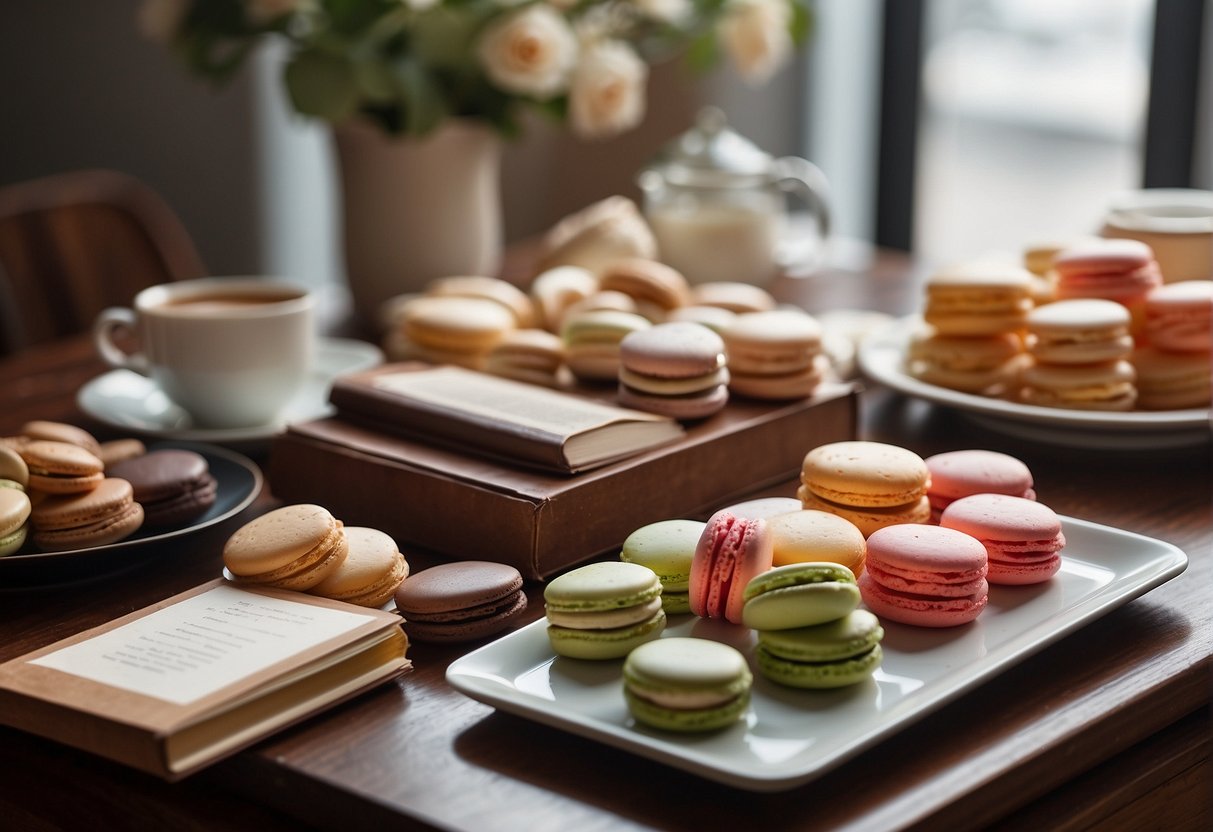
In this section, I cover some of the most common questions bakers ask when it comes to selecting the right tools for baking macarons. I focus on the essential features of baking sheets and other tools that influence the outcome of these delicate treats.
What features should I look for in a baking sheet for flawless macaron results?
A baking sheet for macarons should have a flat surface, low sides, and be able to distribute heat evenly. Non-stick surfaces or accompanying silicone mats can be very helpful for easy release of the macarons after baking.
Which material is preferable for a macaron baking sheet, aluminum or stainless steel?
Aluminum baking sheets are typically preferred for macarons as they are excellent heat conductors, promoting even baking. However, some bakers also achieve great results with heavy-gauge stainless steel that doesn’t warp under high heat.
Is a silicone baking mat advantageous over parchment paper when making macarons?
Yes, a silicone baking mat is often advantageous as it provides a non-stick surface and can feature guides for piping consistent macarons. They are also reusable, which is environmentally friendly compared to parchment paper.
What size and style of piping tip yields the best results for macaron shells?
A round piping tip, usually between 1/2 inch to 5/8 inch in diameter, gives the best control and results in uniformly rounded macaron shells, important for an even rise and an aesthetically pleasing outcome.
Can the type of baking sheet affect the feet and texture of macarons?
The type of baking sheet can definitely affect the feet and texture. Sheets that distribute heat poorly can lead to lopsided macarons, while good heat distribution will promote the formation of well-defined feet and a smooth surface.
How do macaron baking sheets with templates compare to traditional flat sheets?
Baking sheets with templates can assist in piping evenly sized macarons and provide a visual guide to help keep rows neat. Macaron baking sheets with templates can be particularly useful for beginners to ensure consistency in size and shape.
Raspberry Macarons Recipe
Course: DessertCuisine: FrenchDifficulty: Medium24
servings1
hour30
minutesThese macarons are bursting with fruity raspberry flavor and are sure to impress your family and friends!
Ingredients
1 cup (about 3 large eggs) aged egg whites
1/4 cup granulated sugar (about 2 ounces)
2 cups powdered sugar (about 8 ounces)
1 cup almond flour (about 4 ounces)
1/4 teaspoon cream of tartar
For the Raspberry Filling:
1/2 cup fresh raspberries (about 2.5 ounces)
1 tablespoon granulated sugar (about 0.5 ounces)
1/2 cup unsalted butter, softened (1 stick, about 4 ounces)
2 cups powdered sugar (about 8 ounces)
1/2 teaspoon vanilla extract
Directions
- Prepare Baking Sheets: Line two baking sheets with parchment paper or silicone mats. Prepare a piping bag with a round tip.
- Prepare the Dry Ingredients: In a medium bowl, sift together the powdered sugar and almond flour. Set aside.
- Whip the Egg Whites: In a clean, dry mixing bowl, beat the aged egg whites on medium speed until frothy. Add the cream of tartar and continue beating until soft peaks form. Gradually add the granulated sugar and continue beating until stiff, glossy peaks form.
- Macaronage: Sift the dry ingredients over the whipped egg whites. Using a spatula, gently fold the dry ingredients into the egg whites until the batter is smooth and flows like lava. Be careful not to overmix.
- Pipe Macarons: Transfer the batter to the prepared piping bag and pipe small circles onto the lined baking sheets, spacing them about 1 inch apart. Tap the baking sheets on the counter to release any air bubbles. Let the piped macarons rest at room temperature for 30-60 minutes, until a skin forms on the surface.
- Preheat Oven: While the macarons are resting, preheat the oven to 300°F.
- Bake Macarons: Once the macarons have rested, bake them in the preheated oven for 15-18 minutes, rotating the pans halfway through baking, until the macarons are set and easily lift off the parchment paper. Allow the macarons to cool completely on the baking sheets before removing them.
- Make the Raspberry Filling: In a small saucepan, combine the fresh raspberries and granulated sugar. Cook over medium heat, stirring occasionally, until the raspberries break down and the mixture thickens slightly, about 5-7 minutes. Remove from heat and let cool completely. In a separate bowl, beat the softened butter until creamy. Gradually add the powdered sugar and vanilla extract, then add the cooled raspberry mixture. Beat until smooth and well combined.
- Assemble the Macarons: Match up the cooled macaron shells into pairs of similar size. Spoon or pipe a small amount of raspberry filling onto one shell of each pair, then gently sandwich them together.
- Chill and Serve: Place the assembled macarons in an airtight container and refrigerate for at least 24 hours to allow the flavors to meld and the filling to set. Bring to room temperature before serving.


